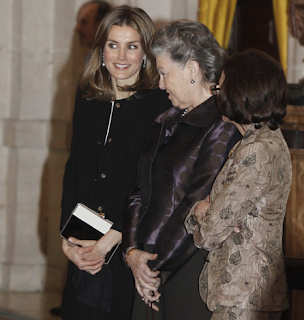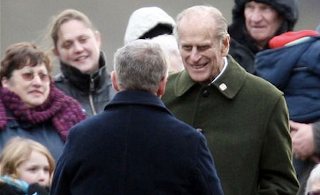THE FOUR GRACES; Queen Victoria’s Hessian Granddaughters, by Ilana D. Miller [Kensington House Books, Eurohistory.com, California 2011] 256 pages, 80 black and white illustrations, family trees.
Opening with a description of Kensington Palace and the surrounding park, Ilana Miller’s long-awaited group biography, The Four Graces, takes the story of one of the Palace’s latter-day residents – Victoria Mountbatten, Dowager Marchioness of Milford Haven – and recounts it both for its own sake and as context for the lives of the more prominent Hesse sisters, Ella, Grand Duchess Sergei Alexandrovich of Russia, and Alix, the last Russian Empress, and of the fourth ‘Grace’, Irène, Princess Henry of Prussia. The author makes the point at the outset that in choosing to marry a prince regarded as ‘unequal’ by most of her royal relatives Victoria opted out of the dynastic rat-race at the start of her adult life. And yet, two generations on and with most of the European thrones consigned to history, we are taken into the story with an imagined vignette of an elderly Victoria opening the invitation to her grandson Philip’s wedding to the heir to the British throne – the dynastic triumph of the Mountbattens. This sets the book’s underlying theme (of which more later!)
The text proper begins with Victoria’s birth before slipping back in time to her parents’ wedding, then in location to Darmstadt, the family home, and to the Hesse relatives. Then back to Victoria, her christening and infancy and the coming of Ella and Irène, completing the circle of the original ‘three Graces’.
The story of their mother’s married life and the upbringing of her growing family is well-known and has often been told from a variety of perspectives. Here the emphasis is definitely on Victoria with the other sisters – and brothers – making their appearance and fading from view up to the moment we know must come: the diphtheria epidemic of 1878 which claimed their mother Princess Alice and her youngest child, leaving Victoria at 15 with a heavy burden of responsibility for the whole family.
And so the story proceeds into the 1880s, with the younger sisters coming forward more clearly as they grow but never challenging the central focus on Victoria. She emerges as very much the older sister, watching over the others, discussing them with Queen Victoria, occasionally telling them what to do. Her own unconventional character traits become apparent and as the first part of the book ends we see her on the eve of her marriage.
Part two takes us through the 1880s and 90s, from Victoria’s marriage to the death of her grandmother Queen Victoria, with all the incidents in between: her father’s unfortunate and hastily-annulled second marriage, Ella’s removal to Russia and to a life so unlike her sister’s, the arrival of Victoria’s elder children and her continued management of the lives of her younger siblings. We see Princess Beatrice’s marriage to Victoria’s brother-in-law Henry of Battenberg, her other brother-in-law Alexander’s misadventure in Bulgaria, her father’s death and the marriages of the younger sisters. Through quotations from letters we hear the characters’ own reactions to events, adding life to the account and colour to the descriptions of them. The amount of attention paid to the siblings varies: Ernst Ludwig, the brother, receives as much attention as the two younger sisters if not more, perhaps because his position was more important at this time and Victoria was more concerned for him.
Now the account moves on to the aftermath of the Queen’s death, its impact on the wider family, and all the upheavals and dramas of the first two decades of the new century. Through family letters we see the breakdown of Grand Duke Ernst Ludwig’s marriage and his concerns for his child, the engagement of Victoria’s eldest child Alice and her marriage – the occasion for a grand family reunion. The letters capture the deaths of little Elisabeth of Hesse and Heinrich of Prussia, the Grand Duke’s happy second marriage, the assassination of Ella’s husband Grand Duke Sergei and the years leading up to the First World War. Through the eyes of the family we see the four years of conflict, which two of the sisters would not survive. This third section of book also covers the years immediately following the war, the discovery and removal to Jerusalem of Ella’s body and the death of Victoria’s husband Louis.
And finally come the last three decades, the 1920s, 30s and 40s, when only two ‘Graces’, Victoria and Irène remain, together with their brother, and all three watch as the next generation moves forward into the spotlight. For me this is the most appealing part of the book, perhaps because it is also the least familiar. It describes Victoria’s friendship with Queen Mary: ‘ever since I knew you better as a girl when I stopped at White Lodge with your parents & later when we took a walk together soon after your marriage, I have felt more warmly towards you than just as one does to a relation because of the relationship,’ Victoria tells the Queen. It shows the pairings-off of the children and the arrival of grandchildren – great-grandchildren too. We see the many troubles faced by relatives in exile, and the family’s reaction to everything from purely family events to the rise of the Nazis in Germany. The Second War follows and its aftermath, and we come full circle to the wedding of Victoria’s grandson Philip and Princess Elizabeth, and the birth of their eldest child, with Victoria’s death in 1950 as the closing act. A brief epilogue describes her funeral and the final years and death of the last ‘Grace’, Princess Irène. The last paragraphs of the book draw the moral implied at the start: that Alix and Ella, ‘the wives of autocratic men of a fallen empire’ both ‘grounded in the traditions of absolute monarchy. Lavish pageantry, the mysteries of religion, and the prescribed roles of a divinely appointed Imperial Family’ were ‘very much nineteenth century women’. Irène was ‘the royal princess to the end as her family quietly slipped into obscurity’ and ‘in some ways self-deluding’. Victoria, on the other hand, ‘fell squarely into the twentieth century’ as the matriarch of ‘a most successful and modern family.’ All four, we are told, ‘fashioned their lives. . . and consequently met their inevitable fates.’
It is probably fair to say that the Hesse children are the most popular and the most intriguing family group among Queen Victoria’s many grandchildren, and The Four Graces has received a rapturous reception. For anyone interested in the family it is a thoroughly enjoyable read, based on years of original research and full of new details and insights and unfamiliar quotations. To a great extent it is a book written around the family’s letters and this is its strength. Everything that happens happens through their eyes. We see their reactions to events, their explanations to one another, and we only glimpse the broader canvas against which their lives were set. Family biography represents a challenge to a writer. Most opt for the easy ‘first I’ll talk about this person, now I’ll move on to that person’ approach, which works reasonably well but never allows for consideration of the family as a family. The emphasis on correspondence in The Four Graces has allowed Ilana Miller to look at the relationships between the siblings and I like that very much in this book. A little more weight given to the younger sisters would have been interesting, but the unexpected compensation for this is the focus on the relationship between Victoria and her brother.
For me the only drawbacks of the book are technical ones. It has the feel of a large text squeezed into a small format, with tiny print and small margins. The pictures are excellent and many of them extremely unusual, but again one longs to give them room to breathe. More careful proof-reading would also have helped. But really these are niggling details. No one would forego the chance to read a new perspective on a subject of interest because the proof-reading could be improved, and in The Four Graces Ilana Miller has collected some fascinating new material on a compelling subject. Her sympathy for Victoria Milford Haven shines through the text. She traces her way thoughtfully through the story and has also drawn a thought-provoking moral on the lives of the sisters (seen from a republican standpoint, perhaps?) which is sure to provoke some fascinating discussion.
by Charlotte Zeepvat
































